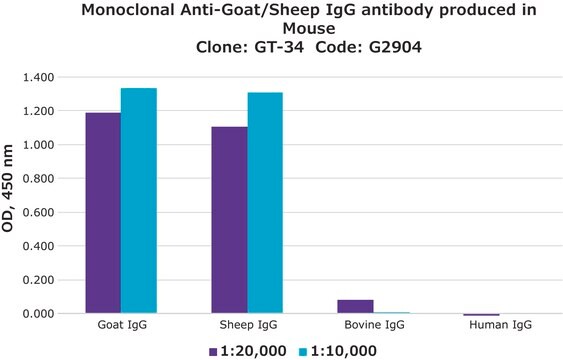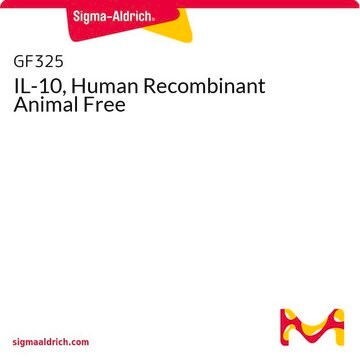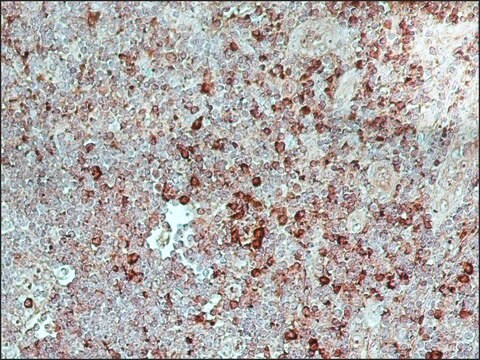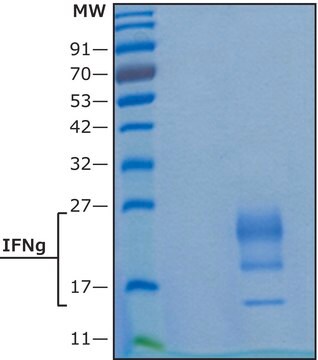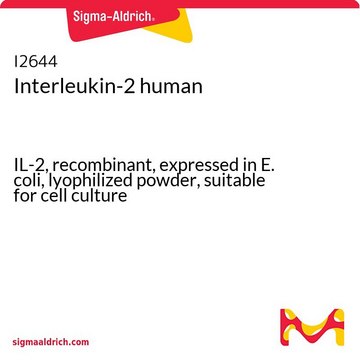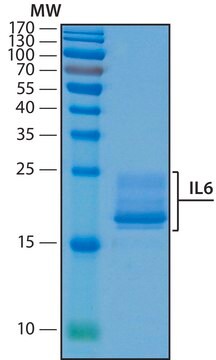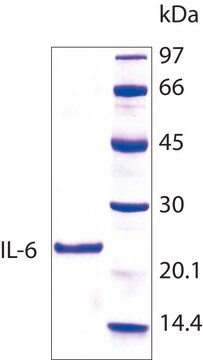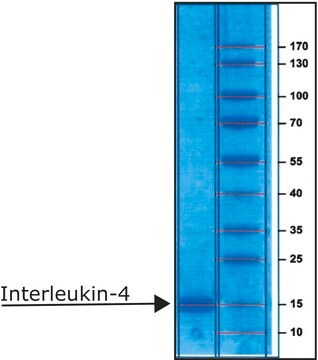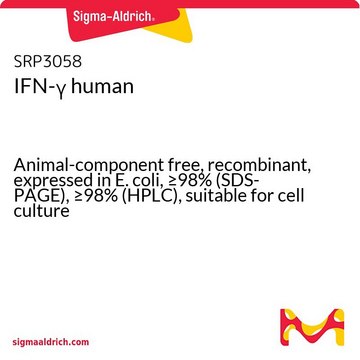H7541
IL-10 human
HumanKine®, recombinant, Xeno-free, >95% (SDS-PAGE), suitable for cell culture
Synonym(s):
IL-10
Sign Into View Organizational & Contract Pricing
All Photos(1)
About This Item
Recommended Products
Product Name
Interleukin-10 human, IL-10, recombinant, expressed in HEK 293 cells, HumanKine®, suitable for cell culture
biological source
human
Quality Level
recombinant
expressed in HEK 293 cells
Assay
≥95% (SDS-PAGE)
form
lyophilized powder
potency
≤1.5 ng/mL EC50
quality
endotoxin tested
mol wt
dimer 17 kDa (glycosylated)
technique(s)
cell culture | mammalian: suitable
impurities
≤1EU/mg
UniProt accession no.
storage temp.
−20°C
Gene Information
human ... IL10(3586)
Looking for similar products? Visit Product Comparison Guide
General description
Interleukin-10 gene with five exons is mapped to human chromosome 1. The gene codes for 35 kD protein containing 178 amino acids. IL-10 is a homodimer with two, non-covalently bonded monomers.
Application
Interleukin-10 human has been used to study its effect on activation of endogenous signal transducer and activator of transcription 1 (STAT1)/STAT3 in the knock-in, in A549 human lung adenocarcinoma cell line.
Biochem/physiol Actions
IL-10 is an important regulator of the functions of lymphoid and myeloid cells. IL-10 can block the activation of cytokine synthesis and several accessory functions of macrophages. Human and mouse IL-10 share a 73% sequence homology. However, human IL-10 acts on both human and mouse target cells, while mouse IL-10 has species-specific activity. In mouse, the cellular sources of IL-10 consist of Th2 cells, activated fetal thymocytes, macrophages, keratinocytes, LY-1+ (CD5+), and normal B cells. In human, the cellular sources of IL-10 consist of CD4+ T cells and T cell clones, thymocytes, B cells, B cell lymphomas, macrophages, mast cell lines and keratinocytes. IL-10 stimulates the growth of stem cells, mast cells and thymocytes. IL-10 enhances cytotoxic T cell development, and co-stimulates B cell differentiation and Ig secretion. IL-10 regulates angiogenesis by inducing the cell-type dependent expression of either angiogenic or angiostatic factors.
Interleukin-10 regulates lymphoid and myeloid cell functions. It blocks the activation of cytokine synthesis and several accessory functions of macrophages. IL-10 enhances cytotoxic T cell development and co-stimulates B cell differentiation and Ig secretion. IL-10 regulates angiogenesis by inducing cell-type dependent expression of either angiogenic or angiostatic factors.
Physical form
Lyophilized from a 0.2 μm filtered solution of 10mM Tris-HCl pH 7.4 + 150mM NaCl
Preparation Note
HumanKine Interleukin-10 (IL-10) is expressed in human HEK 293 cells as a glycosylated, non-disulfide linked homodimer with an apparent molecular mass of 17 kDa due to glycosylation. Glycosylation contributes to stability in cell growth media and other applications.
Analysis Note
The specific activity was determined by the dose-dependent stimulation of the proliferation of MC/9 cells (mouse master cell line) in presence of 200 pg/mL IL-4.
Legal Information
HumanKine is a registered trademark of Proteintech Group, Inc. and Humanzyme, Inc
Storage Class Code
11 - Combustible Solids
WGK
WGK 3
Flash Point(F)
Not applicable
Flash Point(C)
Not applicable
Choose from one of the most recent versions:
Already Own This Product?
Find documentation for the products that you have recently purchased in the Document Library.
Customers Also Viewed
Biology of interleukin-10
Sabat R, et al.
Cytokine & Growth Factor Reviews, 21(5), 331-344 (2010)
Robert Sabat et al.
Cytokine & growth factor reviews, 21(5), 331-344 (2010-12-01)
Interleukin (IL)-10 is the most important cytokine with anti-inflammatory properties besides TGF-β and IL-35. It is produced by activated immune cells, in particular monocytes/macrophages and T cell subsets including Tr1, Treg, and Th1 cells. IL-10 acts through a transmembrane receptor
Da-En Cheng et al.
Molecular medicine reports, 10(5), 2389-2394 (2014-09-19)
The process of differentiation from monocytes to dendritic cells is critical in immune modulation. Monocyte apoptosis is a key regulator in balancing the immune response. Galectin‑1 has been reported to induce tolerogenic dendritic cells by the autocrine interleukin (IL)‑10 in
Martina Severa et al.
Journal of interferon & cytokine research : the official journal of the International Society for Interferon and Cytokine Research, 35(9), 668-681 (2015-04-30)
Plasmacytoid dendritic cells (pDCs) display altered immune-phenotype in multiple sclerosis (MS) patients and are found actively recruited in postmortem MS brain lesions, implying that their immune regulation may represent an important aspect of MS pathogenesis. Because of the reported Toll-like
Adriana Weinberg et al.
PloS one, 10(4), e0122431-e0122431 (2015-04-16)
Influenza infections have high frequency and morbidity in HIV-infected pregnant women, underscoring the importance of vaccine-conferred protection. To identify the factors that determine vaccine immunogenicity in this group, we characterized the relationship of B- and T-cell responses to pandemic H1N1
Our team of scientists has experience in all areas of research including Life Science, Material Science, Chemical Synthesis, Chromatography, Analytical and many others.
Contact Technical Service